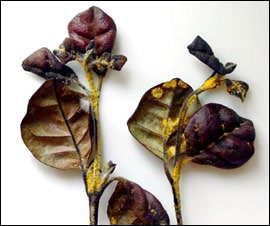PESTS AND DISEASES OF FORESTRY IN NEW ZEALAND
Myrtle Rust and the Forest Industry
Scion is the leading provider of forest-related knowledge in New Zealand
Formerly known as the Forest Research Institute, Scion has been a leader in research relating to forest health for over 50 years. The Rotorua-based Crown Research Institute continues to provide science that will protect all forests from damage caused by insect pests, pathogens and weeds. The information presented below arises from these research activities.
From Forest Health News 269, August 2016.
Myrtle rust, caused by the microscopic fungus Puccinia psidii, has been discussed in earlier issues of Forest Health News (211, 212, 238 and 255). Although native to tropical South America, it has dispersed globally on plants in the family Myrtaceae. One strain has reached a number of Asian and Pacific countries during the past decade and is now sitting on New Zealand’s doorstep. The NZ Forest Owners Association have asked the Forest Protection Group (Scion) to examine what an introduction of this disease might mean for forestry.
Rust fungi disperse readily by airborne urediniospores and there is a history of new rusts arriving in New Zealand from across the Tasman within one or two years of their detection in Australia. Myrtle rust is not yet known in New Zealand, even though it has been present in Australia for at least six years, but it may still arrive here in this manner. Alternatively, the pathogen may be carried to New Zealand by human means on infected plants or as spore deposits on transported goods. Experience overseas indicates that, once established, it is likely to spread rapidly. There are a large number of potential hosts in New Zealand and the climate is suitable over much of the country.

Is the risk of introduction being successfully mitigated and are we prepared? The Ministry for Primary Industries (MPI) has introduced tighter restrictions for imported myrtaceous plants, and has been updating the country’s DNA sequencing capability in collaboration with Scion for quick identification of the pathogen. Scion has also created a DNA sequence library of myrtaceous species to assist with host identification. MPI maintains a free phone “hot line” (0800 80 99 66) for immediate reporting of suspected pest incursions. It also runs a High Risk Site Surveillance (HRSS) programme aimed at detecting new plant pests or pathogens such as P. psidii. Nevertheless, there is still a chance that an initial detection might be too late to attempt eradication, as P. psidii is likely to spread rapidly, especially if it invades during spring or summer.
We do not know what will happen if myrtle rust reaches New Zealand, but there could be significant ecological and commercial impacts. Myrtaceous plants are found throughout the country in native vegetation, parks, gardens and rural settings. Potentially vulnerable industries include retail nurseries and producers of feijoa fruit, tea tree oil, cut flowers and manuka honey. In contrast, forestry is unlikely to be seriously affected. Plantations in New Zealand are composed largely of conifers, and eucalypts make up only 1.4% of the estate. In Australia eucalypts are affected mainly at the juvenile stage with, at most, a low incidence of malformation, though there has been greater impact in Brazil when clonal stock has turned out to be susceptible. However, in the event of an incursion, advice on disease management will be sought by owners of eucalypt plantations. The Forest Protection Group is maintaining a hands-on awareness of myrtle rust and professional staff have studied the disease in Australia.
The myrtle rust issue must be addressed in a concerted way and not in isolation. Should P. psidii be discovered, it is of particular importance that there be a detailed and tested incursion plan already in place to describe the procedures to be followed. This plan would clearly outline in advance the separate responsibilities of the various commercial and non-commercial stakeholders, allocate agreed costs, and include criteria for a decision on whether or not to attempt eradication. With our present knowledge, and in broad terms only, eradication should be attempted if P. psidii is confined to a small, accessible area, especially during autumn or early winter when urediniospores are absent or infrequent. However, if it is found to be widely dispersed, with an abundance of urediniospores, especially during spring or summer, eradication will not be possible and the disease should instead be managed to minimise its impact. Nevertheless, it is paramount that an interim eradication attempt should begin as soon as P. psidii is detected, without waiting for the eventual final judgment that may need to be temporarily delayed until the necessary information is obtained through surveys and by other means.
Ian Hood and Peter Scott (Scion)
This information is intended for general interest only. It is not intended to be a substitute for specific specialist advice on any matter and should not be relied on for that purpose. Scion will not be liable for any direct, indirect, incidental, special, consequential or exemplary damages, loss of profits, or any other intangible losses that result from using the information provided on this site.
(Scion is the trading name of the New Zealand Forest Research Institute Limited.)

 Farm Forestry New Zealand
Farm Forestry New Zealand

